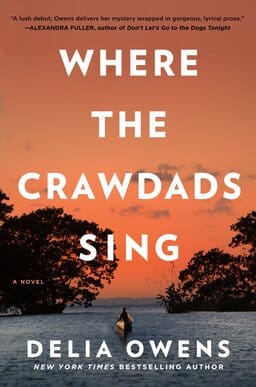Among the values of good fiction is the ability of a story to use the psychological development of its characters to expose moral struggle in the reader. I am not referring to the tension caused by the device of narrative conflict, which has its own utility in good storytelling. Nor am I talking about creating morally ambiguous protagonists and antagonists, then compelling the reader to make a choice between the two — also the ingredient of a compelling tale.
Rather, a good story might also use its characters to probe deeply into the ethical principles of the reader, to expose his own latent conflicts and moral ambiguity. It might use its characters’ actions to challenge the reader’s assurance about her moral standards, upsetting the self-confidence of her convictions and forcing her to examine her own conscience. Delia Owens’ 2018 debut novel, “Where the Crawdads Sing” (adapted into a film in 2022), is successful in pulling off this delicate feat.

Life’s challenges
The story’s bleak beginning establishes a close, sympathetic relationship between the reader and main character, Catherine Danielle Clark, nicknamed “Kya.” Six-year-old Kya is abandoned by her mother, who leaves their home in the marshes of coastal North Carolina to escape Kya’s abusive, alcoholic father. Kya’s four siblings also eventually flee, leaving her alone with her father, whose frequent long absences leave the young girl to fend for herself in the backwoods cabin they call home. For a time, Kya’s days are filled with the hope that her mother will return. Eventually, those hopes fade, and she gives up her mother for dead. Kya resigns herself to life with her violent father until one of his prolonged absences becomes permanent, and she is left alone in the marsh to fend for herself.
The body of the story details Kya’s remarkable resiliency as she adapts to her environment, learning how to survive on her own against the odds set against her. At one point, she has a glimmer of hope when a social worker enrolls her in the local elementary school. Kya is eager to go to school and excited to learn to read. But on the first day of school, “the marsh girl,” shoeless and in her tattered dress, is ridiculed by her elementary school classmates. She flees the school building on that first day, never to return. The social workers come looking for her, but Kya uses her knowledge of the marsh and her skill with her father’s abandoned motor boat to evade them until they give up.
Surviving alone
Owens endows Kya with many admirable qualities, eliciting the sympathy of the reader. She learns how to read and write with the help of a boy who befriends her, for example. She develops an expertise in the flora and fauna of the marshland, eventually even publishing acclaimed books with her own illustrations and descriptions, the kind sold in the gift shops of museums and nature centers. While never leaving the isolation of the marsh, she uses proceeds from her books to renovate her shack home.
But Kya’s most compelling virtue and chief characteristic is her skill at survival. After her father leaves, for example, she begins to harvest mussels from the beach to sell at the local general store. When she discovers that she has competition for the market, she gets up earlier, or doesn’t even go to bed at all, so she can beat her competitors. She becomes an expert at navigating her boat among the shoals and eddies of the tidal coast. She learns to weather storms in the lee of her house, and to survive the fickle winds of the ocean climate. No matter the severity or number of the obstacles that stand between her and survival, Kya overcomes them, usually by her own keen instincts and fierce independence. She seems to be a model of fortitude.
A challenge to the reader
Throughout the account of Kya’s childhood, adolescence and late teen years, a parallel murder mystery unfolds in the nearby town of Barkley Cove. A young man named Chase Andrews is discovered dead in the marsh, having fallen (or been pushed) from a fire tower to his death below. We learn that Kya had once had a budding romantic relationship with Chase until she broke off the connection after discovering his duplicity. When the former romance was discovered by local authorities, Kya became the chief suspect in Chase’s death, and she was eventually tried for his alleged murder.
I will reveal neither the outcome of the trial nor the aftermath of the verdict, as these events go to the heart of the novel’s deepest and most compelling themes. Rather, I commend the novel for the brilliant way it challenges the reader to examine the quality of his own moral convictions and the strength by which he holds them. We may think we understand what the virtue of justice entails, for example, and that we have a firm grip on our own commitment to it. But, as the novel’s title implies, sometimes these convictions are out where the crawdads sing, in the mysterious marshes of moral contingency and the swamps of ethical vagueness. The success of “Where the Crawdads Sing” is found as much in challenging the moral confidence of the reader as in spinning a compelling tale.





